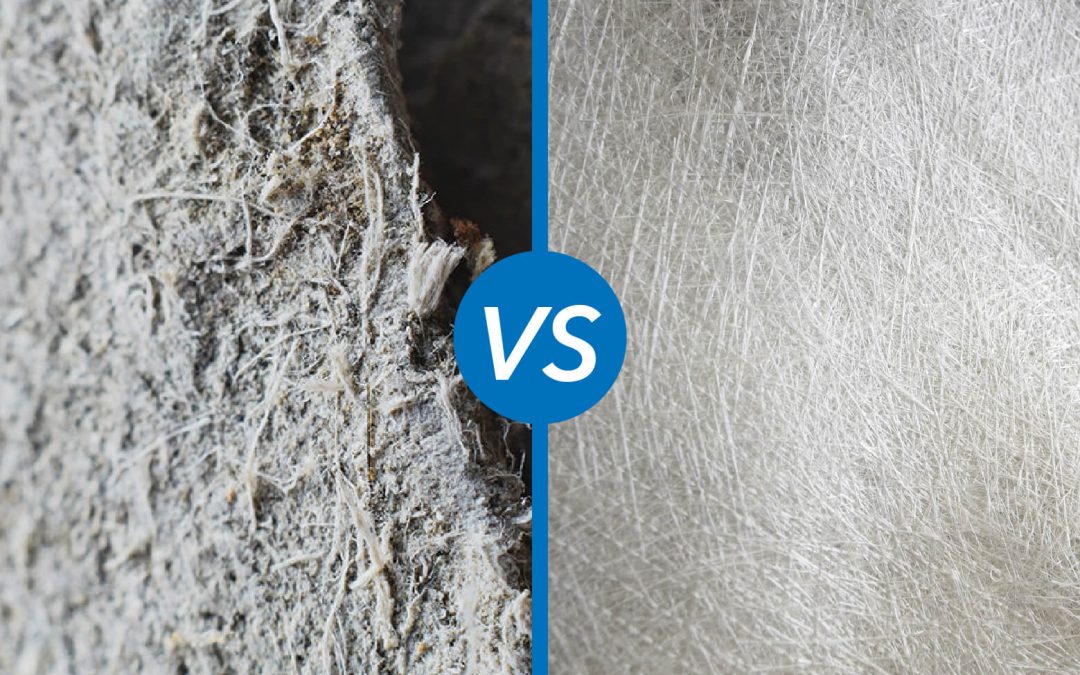Fiberglass Vs. Asbestos
In this post, Ed Kennedy (founder of Haztrainer) will discuss some of the main similarities and differences between Asbestos and Fiberglass. These two materials can easily get confused, so it is important to educate yourself on both of them.
Similarities between fiberglass and asbestos
Basics
Both fiberglass and asbestos are fibrous materials. In fact, fiberglass was considered a decent substitute for asbestos and commonly used until the health effects became apparent. Like asbestos, fiberglass has heat-resistant qualities that make it good for insulation. Fiberglass doesn’t burn or support combustion. It is inorganic and resistant to most chemicals. Asbestos also has unmatched resistance to heat and combustion. Both are excellent performers in thermal environments.
Dangerous health effects
The similarities of fiberglass and asbestos can also be explored in regards to their health effects. Asbestos is classified as a carcinogenic, while modern day fiberglass is not. According to the EPA, exposure to asbestos can cause lung cancer and mesothelioma. After more than 25 years of epidemiology research, the conclusions demonstrate that there is no
adequate evidence of an adverse risk from exposure to fiber glass insulation. These conclusions
are based on the results from well-conducted and extensive epidemiological research.
Official reports issued by government programs i.e., the 13th United States National Toxicology program report on carcinogens, state that there is reasonable basis for classifying fiberglass as a human carcinogen. However, variations of fiberglass are an important determinant in classification.
Safe when properly handled
Both asbestos and fiberglass are safe if handled properly. When products with asbestos are kept intact, they don’t pose immediate risk. Asbestos is only dangerous when the fibers get airborne and inhaled or ingested. The same applies to fiberglass. It only irritates when it comes in contact with the skin and eyes.
CLICK BELOW TO START YOUR FREE ASBESTOS AWARENESS TRAINING DEMO TODAY!

Differences Between Fiberglass and Asbestos
Occurrence Differences
Asbestos is naturally occurring, while fiberglass is man-made. Asbestos has always been present in some soils and rocks. Fiberglass began being commercially synthesized in the 30s. Both may have thin fibers, but one is man-made.
Fiberglass is made from compositions with silica (by fusing silica with minerals containing oxides needed to make a certain composition). After combination, the molten mass is cooled rapidly to prevent crystallization. Asbestos occurs naturally. It is a combination of fibrous minerals that include but aren’t limited to chrysotile, actinolite, anthophyllite, grunerite, and tremolite.
Irritant Properties
The effects of inhaling or ingesting asbestos can take years to experience. The substance can take years to cause cancer. However, fiberglass irritates instantly when it comes into contact with the eyes and skin. Fiberglass causes inflammation of the skin or irritant contact dermatitis. Inhaling fiberglass also causes breathing difficulties that can be experienced almost instantly. Exposure to fiber glass insulation products can cause temporary, mechanical skin irritation.
Extensive work practices have been developed to reduce the possibility of skin irritation during
handling of these materials. The work practices include recommendations for cost-effective
engineering controls, proper respirator use (when necessary), use of protective clothing, and
workplace guidelines.
Safety Levels
While both asbestos and fiberglass have the potential to be dangerous, asbestos is more dangerous. Asbestos can rest safely once installed and only becomes airborne when damaged or mishandled. The same is true for fiberglass. However, one is more carcinogenic. While the classification of fiberglass as a human carcinogen is debatable, asbestos is a proven human carcinogen.
Difference In Properties
Asbestos has a higher heat resistance and tensile strength properties when compared to fiberglass. Fiberglass is more temperature resistant than polyamide and cotton, but it isn’t comparable to asbestos in this regard. However, it offers better tensile strength and continuous operation under high temperatures than asbestos. However, fiberglass can’t match asbestos in regards to cut resistance.
Differences In Use
While both are known for heat resistant uses, they have different uses. Fiberglass is non-conductive, making it a perfect choice for electrical insulation. Fiberglass is also popular in making aircraft boats, automobiles, storage tanks, pipes, bathtubs, septic tanks, roofing, and cladding. While asbestos is also a great insulator, fiberglass can’t match some of its applications. For instance, unlike asbestos, fiberglass can’t be used to make friction materials like brake band linings.
Asbestos is a popular thermal system insulator, reinforcement material, surfacing material, fireproofing material, floor tile material, pipework, and gasket making material. Asbestos can be used to make friction materials such as brake band linings.
Since both asbestos and fiberglass are considered safe when handled properly, the importance of proper training can’t be overemphasized by individuals bound to come into contact with the substances.
Luckily, it is possible for persons who handle substances like asbestos or work in places where asbestos is present to get quick and affordable training online. Haztrainer [https://haztrainer.com/] offers OSHA-approved convenient and affordable training online to individuals working in jobs and industries that require such training.
Looking For Asbestos Awareness Training Online?
Haztrainer is dedicated to providing OSHA certified training for Asbestos Awareness and Lead Awareness totally online! Our training video courses are fast, efficient, and easy to use. After you complete the training videos you can simply print out your certificate. We are now offering sample training videos for free so you can see first hand how great Haztrainer is before you commit to purchasing the entire course.

Recent Comments